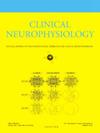高分辨率超声对x连锁肾上腺脑白质营养不良患者周围神经扩大和高回声性的影响
IF 3.6
3区 医学
Q1 CLINICAL NEUROLOGY
引用次数: 0
摘要
背景:周围神经病变在x-连锁肾上腺脑白质营养不良(x-ALD)患者中被观察到。高分辨率超声(HRUS)可以为周围神经病理提供有价值的见解。方法对患者和对照组按1:3的比例行四肢周围神经HRUS。测量神经横截面积(CSA)、超声模式和评分(UPSS)、神经回声性和神经均匀性。此外,所有患者都进行了临床检查和神经传导研究。结果该研究包括51例患者(男性34例,女性17例)和18例年龄和性别匹配的对照组,其中女性患者明显年龄较大。43例患者出现多发性神经病变的临床表现。47例患者在神经传导研究中表现出异常,其变化与轴突和脱髓鞘模式的混合一致。在HRUS上,大多数周围神经表现出明显较大的平均csa值。X-ALD患者的UPSS明显高于对照组(3.7分vs 1.8分,p = 0.026)。较高的UPSS与较高的高回声神经结构显著相关(r = -0.482, p < 0.001)。结论X-ALD患者周围神经明显扩大。此外,观察到增大和高回声增强之间的相关性。意义本研究为加强对X-ALD患者多神经病变的认识提供了一种途径。本文章由计算机程序翻译,如有差异,请以英文原文为准。

Peripheral nerve enlargement and hyperechogenicity in patients with X-linked adrenoleukodystrophy using high-resolution ultrasound
Background
Peripheral neuropathy is observed in patients with X-linked adrenoleukodystrophy (x-ALD). High-resolution ultrasound (HRUS) can provide valuable insights into peripheral nerve pathology.
Methods
Patients and controls in a 1:3 ratio underwent HRUS of peripheral nerves in the arms and legs. Cross-sectional area (CSA), Ultrasound Pattern Sum Score (UPSS), nerve echogenicity, and nerve homogeneity were measured. Additionally, all patients underwent clinical examinations as well as nerve conduction studies.
Results
The study included 51 patients (34 male, 17 female) and 18 age- and sex-matched controls with female patients being significantly older. 43 patients presented with clinical signs of polyneuropathy. 47 patients presented with abnormalities on nerve conductions studies with changes consistent with a mixture of axonal as well as demyelinating patterns. On HRUS, most peripheral nerves exhibited significantly larger mean CSA-values. The UPSS was notably greater in X-ALD patients than in controls (3.7 points vs 1.8 points, p = 0.026). A higher UPSS was significantly associated with a more hyperechoic nerve structure (r = -0.482, p < 0.001).
Conclusion
This study reveals significantly enlarged peripheral nerves in X-ALD patients. Moreover, a correlation between enlargement and increasing hyperechogenicity was observed.
Significance
This study provides an approach to enhance the understanding of polyneuropathic changes in patients with X-ALD.
求助全文
通过发布文献求助,成功后即可免费获取论文全文。
去求助
来源期刊

Clinical Neurophysiology
医学-临床神经学
CiteScore
8.70
自引率
6.40%
发文量
932
审稿时长
59 days
期刊介绍:
As of January 1999, The journal Electroencephalography and Clinical Neurophysiology, and its two sections Electromyography and Motor Control and Evoked Potentials have amalgamated to become this journal - Clinical Neurophysiology.
Clinical Neurophysiology is the official journal of the International Federation of Clinical Neurophysiology, the Brazilian Society of Clinical Neurophysiology, the Czech Society of Clinical Neurophysiology, the Italian Clinical Neurophysiology Society and the International Society of Intraoperative Neurophysiology.The journal is dedicated to fostering research and disseminating information on all aspects of both normal and abnormal functioning of the nervous system. The key aim of the publication is to disseminate scholarly reports on the pathophysiology underlying diseases of the central and peripheral nervous system of human patients. Clinical trials that use neurophysiological measures to document change are encouraged, as are manuscripts reporting data on integrated neuroimaging of central nervous function including, but not limited to, functional MRI, MEG, EEG, PET and other neuroimaging modalities.
 求助内容:
求助内容: 应助结果提醒方式:
应助结果提醒方式:


